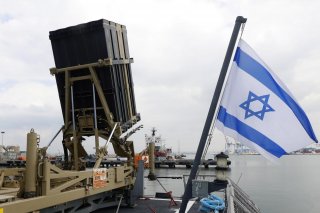Israel's Iron Dome: Just How Good Is It?
That might be hard to figure out. Here’s why.
Israel’s Iron Dome is more than a missile defense system. It’s practically an icon, a symbol of how technological creativity can enable one rocket to knock another rocket out of the sky.
But did the system fail earlier this month? And what does this mean for the U.S. military’s planned buy of Iron Dome?
Any thoughts of an invulnerable missile shield evaporated when Hamas fired six-hundred-and-ninety rockets and mortar shells from Gaza into Israel earlier this month. Out of that six-hundred-and-ninety total, ninety never managed to cross into Israel, according to Israeli figures. Iron Dome intercepted two-hundred-and-forty, of which the Israel Defense Forces claim an 86 percent kill rate, with thirty-five rockets landing in populated areas.
Critics have questioned the accuracy of the IDF’s Iron Dome statistics during the 2014 Gaza conflict. But with four Israeli civilians dead (though one was hit by an anti-tank missile fired directly from Gaza), even Israelis are expressing doubts about the system.
Hamas says it deliberately fired enormous numbers of rockets at a specific target zone to saturate Iron Dome. Some Israeli experts agree that it is difficult to defend against massed salvoes with short flight times when fired from launchers situated a few miles away in Gaza. Israel has ten Iron Dome batteries of three launchers each, firing ten-foot-long Tamir interceptors that cost about $100,000 apiece. Hezbollah, the Iranian-backed force in Lebanon, has an estimated 130,000 rockets.
However, assessing the effectiveness of Iron Dome isn’t easy. For example, the software is supposed to calculate whether a rocket will land in a populated area or empty terrain: interceptors will hit the former while ignoring the latter. So, if a Hamas rocket landed on Israel, was it because Iron Dome failed to intercept it, or Iron Dome chose to ignore it because it didn’t pose a threat?
Ted Postol, professor emeritus at the Massachusetts Institute of Technology and a longtime critic of Israeli and American missile defense, said Youtube video of Iron Dome interceptions showed the system isn’t working. To hit and destroy the warhead, rather than the missile fuselage, an Iron Dome interceptor must strike a rocket head-on, according to Postol. The video that shows contrails from interceptors doing U-turns, or diving down on their target, indicates that the interceptor did not destroy the warhead.
Postol dismissed the IDF’s claim of an 86 percent interception rate. “5 to 10 percent is more likely,” he said. “It’s not Iron Dome. It’s Iron Sieve.”
The latest performance of Iron Dome, first deployed in 2011 and used extensively against Hamas rockets in the 2014 Israel-Gaza conflict, will interest the U.S. Marine Corps. The Marines are considering whether to purchase Iron Dome to defend against rocket attacks. Iron Dome has also been mentioned as a possibility for the U.S. Army.
But the most important question is what Iron Dome’s latest combat record means for strategic missile defense. Hamas’s saturation tactics illustrate the problems faced with stopping ICBMs from Russia, China or even North Korea: an attacker can overwhelm ballistic missile defenses by firing enough missiles and warheads, or at least enough warheads plus decoys to confuse the defense system.
But James Acton, a missile defense expert at the Carnegie Endowment for International Peace, says not to read too much into Gaza when it comes to U.S. strategic missile defense. Without knowing whether Iron Dome deliberately avoided intercepting some Hamas rockets, or tried but failed to intercept them, it’s hard to judge the effectiveness of the system. “To be clear, I do think homeland missile defense is vulnerable to saturation,” Acton told the National Interest. “I’m just not sure this is a good example of that.”
Michael Peck is a contributing writer for the National Interest. He can be found on Twitter and Facebook.
Image: Reuters
This article was first published in 2019.

